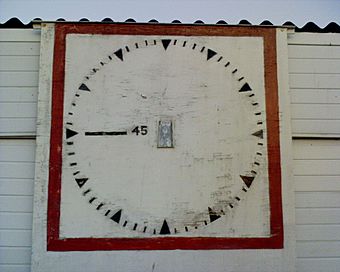Earlsmead Stadium facts for kids
|
Earlsmead
|
|
 |
|
| Full name | Earlsmead Stadium |
|---|---|
| Location | London Borough of Harrow |
| Owner | Harrow Borough F.C. |
| Capacity | 3,070 |
| Field size | 111 x 71 yards |
| Construction | |
| Built | 1934 |
| Opened | 1934 |
| Tenants | |
| Harrow Borough F.C. | |
Earlsmead Stadium is a football ground in Harrow, north-west London, England. It is the home ground of Harrow Borough F.C..
The stadium can hold up to 3,070 fans. This includes 350 seats and space for 1,000 people to stand under cover. The most people ever to watch a game here was 3,000. This happened in 1946 during an FA Cup match against local rivals Wealdstone FC.
Contents
History of Earlsmead Stadium
Harrow Borough F.C. started playing at Earlsmead in 1934. This was just one year after the club was formed. Before that, they played their first season on Northolt Road.
Early Buildings and World War II
In 1938, a building called a pavilion was moved to Earlsmead. A local landowner, Mr. G. Champniss, gave it to the club. It was named the Champniss Stand. This stand had room for 250 people to sit and 100 people to stand.
During World War II, the pavilion was "blacked out." This meant no light could escape, helping the club continue playing. Signs were made from biscuit tins with holes punched out. These signs used hurricane lamps to show the way.
In 1947-48, more cover was added using old metal sheets. These came from Anderson shelters, which were small bomb shelters. Steel tubes from the government were also used. You can still see parts of this covered area today.
Changes and New Developments
Earlsmead originally had two football pitches. But in the early 1970s, one pitch was sold. The local council bought it to build Earlsmead Primary School.
With the money from the sale, Harrow Borough F.C. built new things. They added a new clubhouse and bright floodlights. They also put in new concrete areas for fans to stand. While these big changes happened, the team played their 1973–74 season at other grounds.
In 1995, the old Champniss Stand was taken down after 57 years. A new, modern stand was built to meet safety rules. This new stand has 350 seats. It was paid for by donations and money raised by the club and the Football Foundation.
Where is Earlsmead Stadium?
Earlsmead Stadium is on land that used to be common ground. It's in the far west part of Roxeth. This area was once known as Dabbs Field.
Around 850 AD, a battle might have happened in this area. Some local place names, like Bonefield, might remember it.
Metro-land and Street Names
The area around the stadium was built in the early 1930s. This was part of the "Metro-land" developments. These were new housing areas built along the Metropolitan Railway lines. A nearby housing area, the Earlsmead Housing Estate, likely gave the stadium its name.
Many streets around the stadium are named after famous castles in the British Isles. These include Windsor, Warwick, Kenilworth, Walton, Arundel, Corfe, Balmoral, Ludlow, and Tregenna. A few exceptions exist, like Holyrood Avenue, named after a palace.
How to Get to Earlsmead
Earlsmead Stadium is easy to reach by public transport. It is within a 15-minute walk of three London Underground stations:
- Rayners Lane (Metropolitan and Piccadilly lines)
- South Harrow (Piccadilly line)
- Northolt (Central line)
Northolt Park (on the Chiltern Line) is also nearby. Bus routes 140 and 114 stop very close to the ground. The H10 bus through Rayners Lane and the 282 bus through Northolt also pass by.

